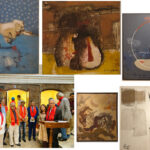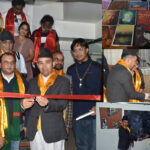Artists from various regions often possess distinct identities rooted in the rich histories of their practiced cultures, carrying out unique rituals. Similarly, the artistic traditions themselves have been revered over extended periods. Some artworks are created with the intent of allowing the wider public to engage in these rituals. Nepal, with its distinctive culture and its specific style of paintings, exemplifies this. Likewise, India boasts similar cultural practices. The transmission of both the culture and the artworks, along with the artworks themselves, occurs seamlessly from one generation to the next.

In the Indian state of Rajasthan, Princess Vaishnavi Kumari developed a profound affinity for the arts and artifacts during her formative years. She observed numerous artisans coming to her palace to craft these pieces. Unfortunately, this artistic tradition did not carry forward from her ancestors to her generation, owing to various circumstances. Seeking to further her artistic education, she journeyed to the United Kingdom. Upon completing her degree in the arts, she returned to her homeland, initially unsure of her next steps. Eventually, she began to connect and collaborate with local artists. She christened her venture an ” Studio Kishangarh,” as an atelier and the artists she enlisted became full-time members of the studio. This arrangement provided them with financial stability, allowing them to dedicate themselves fully to their craft.
In establishing the studio, she also explored avenues for self-sustainability. It comprised not only artists specializing in sketches but also artisans skilled in crafting various handmade items. These meticulously crafted handicrafts have found buyers in various business establishments, largely due to the studio’s reputation. The paintings are created using a blend of natural and acrylic colors. For the natural hues, they employ distinct methods, meticulously preparing stone-based pigments to achieve the desired effect in the artworks.

In the creation of acrylic paintings, multiple artists may collaborate on a single piece, while in some cases, a single artist may undertake the entire artwork. Consequently, individual names are not inscribed on the canvas. Instead, the atelier’s name and a certificate of authenticity are furnished to purchasers, ensuring the credibility of the piece.
Princess Vaishnavi, true to her name, has upheld a generations-old tradition of worshipping Krishna. Their forebears revered Krishna under the name ‘Thakur Shab.’ The manner in which they conduct this worship is distinctive. Throughout the day, Thakur Shab is ceremoniously bathed four times, and the attire adorning the statue is changed with each bathing.

The exhibited painting collections encompass a wide range, spanning from ancient Pichhwai artworks dedicated to the adoration of Lord Krishna. The Pichhwai paintings featured are meticulously crafted on cotton fabric, skillfully draped in an array of vibrant hues, each depicting imagery of Lord Krishna.
A diverse array of artists, art collectors, and enthusiasts convene to appreciate the exhibited paintings. The displayed art forms pique the curiosity of numerous visitors, successfully capturing the interest of a substantial audience. The exhibition is going on at the Siddhartha Art Gallery from 8th of October till the 16th of November.










Leave A Comment